Junho Lee
Finding NeMo: Negative-mined Mosaic Augmentation for Referring Image Segmentation
Nov 03, 2024



Abstract:Referring Image Segmentation is a comprehensive task to segment an object referred by a textual query from an image. In nature, the level of difficulty in this task is affected by the existence of similar objects and the complexity of the referring expression. Recent RIS models still show a significant performance gap between easy and hard scenarios. We pose that the bottleneck exists in the data, and propose a simple but powerful data augmentation method, Negative-mined Mosaic Augmentation (NeMo). This method augments a training image into a mosaic with three other negative images carefully curated by a pretrained multimodal alignment model, e.g., CLIP, to make the sample more challenging. We discover that it is critical to properly adjust the difficulty level, neither too ambiguous nor too trivial. The augmented training data encourages the RIS model to recognize subtle differences and relationships between similar visual entities and to concretely understand the whole expression to locate the right target better. Our approach shows consistent improvements on various datasets and models, verified by extensive experiments.
Scalable Frame Sampling for Video Classification: A Semi-Optimal Policy Approach with Reduced Search Space
Sep 09, 2024Abstract:Given a video with $T$ frames, frame sampling is a task to select $N \ll T$ frames, so as to maximize the performance of a fixed video classifier. Not just brute-force search, but most existing methods suffer from its vast search space of $\binom{T}{N}$, especially when $N$ gets large. To address this challenge, we introduce a novel perspective of reducing the search space from $O(T^N)$ to $O(T)$. Instead of exploring the entire $O(T^N)$ space, our proposed semi-optimal policy selects the top $N$ frames based on the independently estimated value of each frame using per-frame confidence, significantly reducing the computational complexity. We verify that our semi-optimal policy can efficiently approximate the optimal policy, particularly under practical settings. Additionally, through extensive experiments on various datasets and model architectures, we demonstrate that learning our semi-optimal policy ensures stable and high performance regardless of the size of $N$ and $T$.
Isometric Representation Learning for Disentangled Latent Space of Diffusion Models
Jul 16, 2024Abstract:The latent space of diffusion model mostly still remains unexplored, despite its great success and potential in the field of generative modeling. In fact, the latent space of existing diffusion models are entangled, with a distorted mapping from its latent space to image space. To tackle this problem, we present Isometric Diffusion, equipping a diffusion model with a geometric regularizer to guide the model to learn a geometrically sound latent space of the training data manifold. This approach allows diffusion models to learn a more disentangled latent space, which enables smoother interpolation, more accurate inversion, and more precise control over attributes directly in the latent space. Our extensive experiments consisting of image interpolations, image inversions, and linear editing show the effectiveness of our method.
Semi-Supervised Domain Adaptation Using Target-Oriented Domain Augmentation for 3D Object Detection
Jun 17, 2024



Abstract:3D object detection is crucial for applications like autonomous driving and robotics. However, in real-world environments, variations in sensor data distribution due to sensor upgrades, weather changes, and geographic differences can adversely affect detection performance. Semi-Supervised Domain Adaptation (SSDA) aims to mitigate these challenges by transferring knowledge from a source domain, abundant in labeled data, to a target domain where labels are scarce. This paper presents a new SSDA method referred to as Target-Oriented Domain Augmentation (TODA) specifically tailored for LiDAR-based 3D object detection. TODA efficiently utilizes all available data, including labeled data in the source domain, and both labeled data and unlabeled data in the target domain to enhance domain adaptation performance. TODA consists of two stages: TargetMix and AdvMix. TargetMix employs mixing augmentation accounting for LiDAR sensor characteristics to facilitate feature alignment between the source-domain and target-domain. AdvMix applies point-wise adversarial augmentation with mixing augmentation, which perturbs the unlabeled data to align the features within both labeled and unlabeled data in the target domain. Our experiments conducted on the challenging domain adaptation tasks demonstrate that TODA outperforms existing domain adaptation techniques designed for 3D object detection by significant margins. The code is available at: https://github.com/rasd3/TODA.
Enhancing Effectiveness and Robustness in a Low-Resource Regime via Decision-Boundary-aware Data Augmentation
Mar 22, 2024Abstract:Efforts to leverage deep learning models in low-resource regimes have led to numerous augmentation studies. However, the direct application of methods such as mixup and cutout to text data, is limited due to their discrete characteristics. While methods using pretrained language models have exhibited efficiency, they require additional considerations for robustness. Inspired by recent studies on decision boundaries, this paper proposes a decision-boundary-aware data augmentation strategy to enhance robustness using pretrained language models. The proposed technique first focuses on shifting the latent features closer to the decision boundary, followed by reconstruction to generate an ambiguous version with a soft label. Additionally, mid-K sampling is suggested to enhance the diversity of the generated sentences. This paper demonstrates the performance of the proposed augmentation strategy compared to other methods through extensive experiments. Furthermore, the ablation study reveals the effect of soft labels and mid-K sampling and the extensibility of the method with curriculum data augmentation.
SoftEDA: Rethinking Rule-Based Data Augmentation with Soft Labels
Feb 08, 2024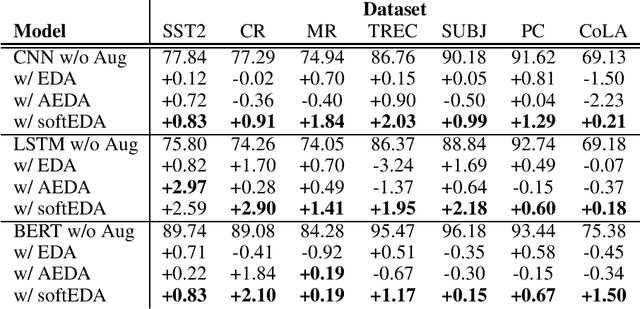

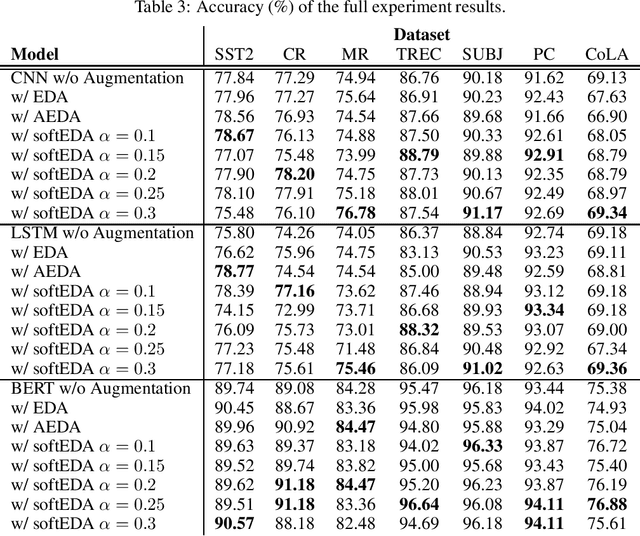
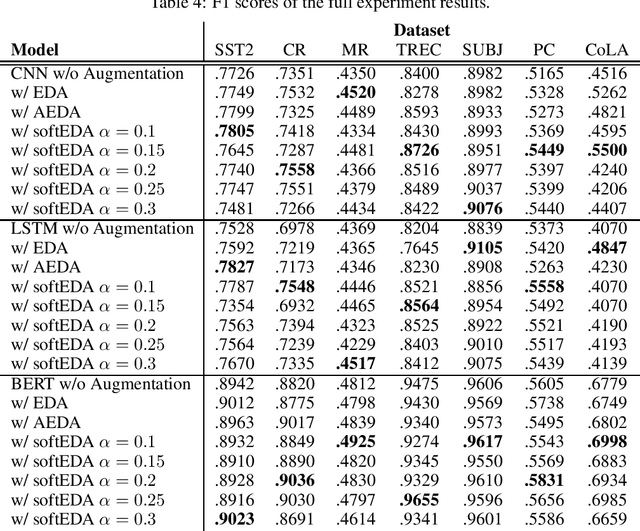
Abstract:Rule-based text data augmentation is widely used for NLP tasks due to its simplicity. However, this method can potentially damage the original meaning of the text, ultimately hurting the performance of the model. To overcome this limitation, we propose a straightforward technique for applying soft labels to augmented data. We conducted experiments across seven different classification tasks and empirically demonstrated the effectiveness of our proposed approach. We have publicly opened our source code for reproducibility.
AutoAugment Is What You Need: Enhancing Rule-based Augmentation Methods in Low-resource Regimes
Feb 08, 2024


Abstract:Text data augmentation is a complex problem due to the discrete nature of sentences. Although rule-based augmentation methods are widely adopted in real-world applications because of their simplicity, they suffer from potential semantic damage. Previous researchers have suggested easy data augmentation with soft labels (softEDA), employing label smoothing to mitigate this problem. However, finding the best factor for each model and dataset is challenging; therefore, using softEDA in real-world applications is still difficult. In this paper, we propose adapting AutoAugment to solve this problem. The experimental results suggest that the proposed method can boost existing augmentation methods and that rule-based methods can enhance cutting-edge pre-trained language models. We offer the source code.
User Guide for KOTE: Korean Online Comments Emotions Dataset
May 11, 2022



Abstract:Sentiment analysis that classifies data into positive or negative has been dominantly used to recognize emotional aspects of texts, despite the deficit of thorough examination of emotional meanings. Recently, corpora labeled with more than just valence are built to exceed this limit. However, most Korean emotion corpora are small in the number of instances and cover a limited range of emotions. We introduce KOTE dataset. KOTE contains 50k (250k cases) Korean online comments, each of which is manually labeled for 43 emotion labels or one special label (NO EMOTION) by crowdsourcing (Ps = 3,048). The emotion taxonomy of the 43 emotions is systematically established by cluster analysis of Korean emotion concepts expressed on word embedding space. After explaining how KOTE is developed, we also discuss the results of finetuning and analysis for social discrimination in the corpus.
Do Not Escape From the Manifold: Discovering the Local Coordinates on the Latent Space of GANs
Jun 13, 2021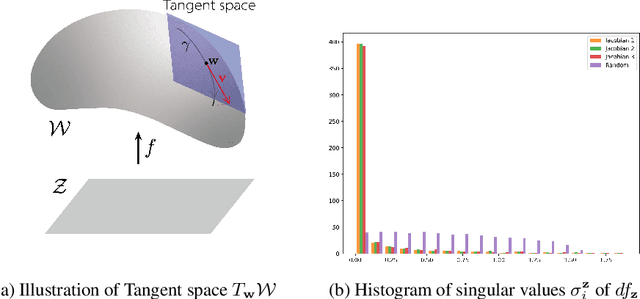
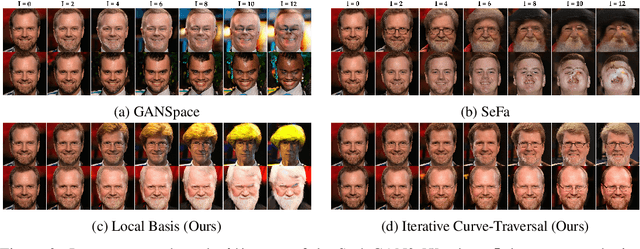
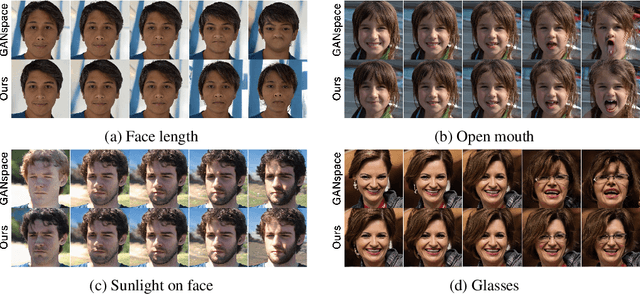

Abstract:In this paper, we propose a method to find local-geometry-aware traversal directions on the intermediate latent space of Generative Adversarial Networks (GANs). These directions are defined as an ordered basis of tangent space at a latent code. Motivated by the intrinsic sparsity of the latent space, the basis is discovered by solving the low-rank approximation problem of the differential of the partial network. Moreover, the local traversal basis leads to a natural iterative traversal on the latent space. Iterative Curve-Traversal shows stable traversal on images, since the trajectory of latent code stays close to the latent space even under the strong perturbations compared to the linear traversal. This stability provides far more diverse variations of the given image. Although the proposed method can be applied to various GAN models, we focus on the W-space of the StyleGAN2, which is renowned for showing the better disentanglement of the latent factors of variation. Our quantitative and qualitative analysis provides evidence showing that the W-space is still globally warped while showing a certain degree of global consistency of interpretable variation. In particular, we introduce some metrics on the Grassmannian manifolds to quantify the global warpage of the W-space and the subspace traversal to test the stability of traversal directions.
GATSBI: Generative Agent-centric Spatio-temporal Object Interaction
Apr 09, 2021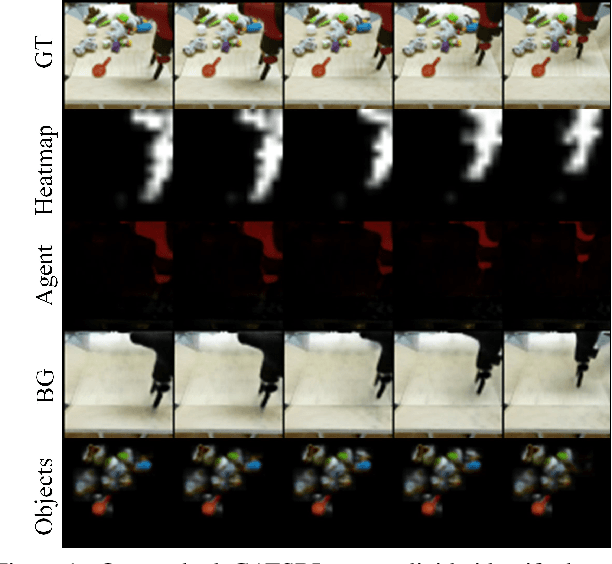

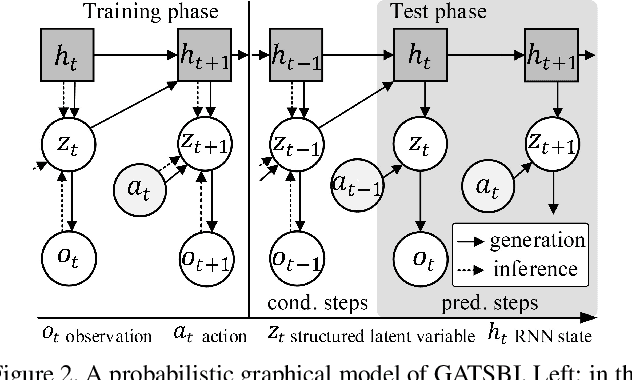
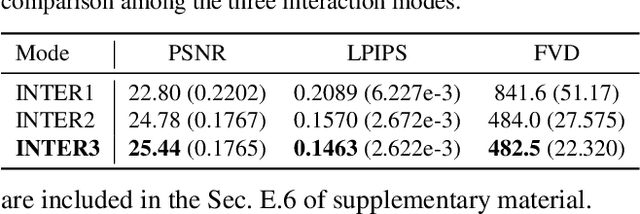
Abstract:We present GATSBI, a generative model that can transform a sequence of raw observations into a structured latent representation that fully captures the spatio-temporal context of the agent's actions. In vision-based decision-making scenarios, an agent faces complex high-dimensional observations where multiple entities interact with each other. The agent requires a good scene representation of the visual observation that discerns essential components and consistently propagates along the time horizon. Our method, GATSBI, utilizes unsupervised object-centric scene representation learning to separate an active agent, static background, and passive objects. GATSBI then models the interactions reflecting the causal relationships among decomposed entities and predicts physically plausible future states. Our model generalizes to a variety of environments where different types of robots and objects dynamically interact with each other. We show GATSBI achieves superior performance on scene decomposition and video prediction compared to its state-of-the-art counterparts.
 Add to Chrome
Add to Chrome Add to Firefox
Add to Firefox Add to Edge
Add to Edge